tow Oldsmobile Cutlass Supreme 1995 Owner's Manuals
[x] Cancel search | Manufacturer: OLDSMOBILE, Model Year: 1995, Model line: Cutlass Supreme, Model: Oldsmobile Cutlass Supreme 1995Pages: 340, PDF Size: 16.68 MB
Page 13 of 340
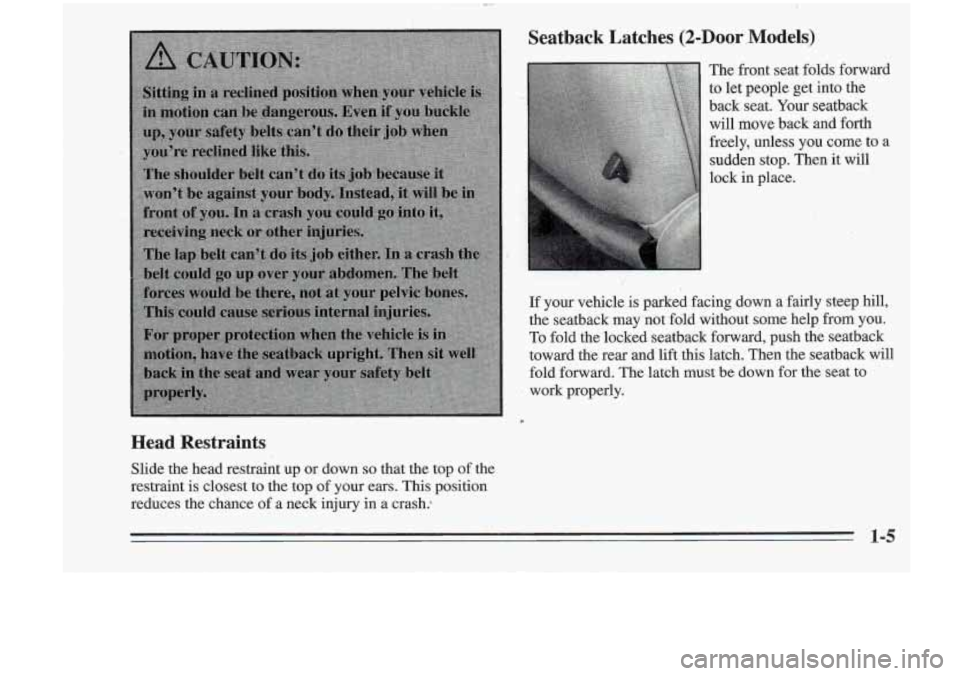
Head Restraints
I
Seatback Latches (2=Door,Models)
The front seat folds forward
to let people get into the
back seat. Your seatback
will move back and forth
freely,
unless YQU come to a
sudden stop. Then it will
lock
in place.
If your vehicle is parked facing down a fairly steep hill,
the seatback may not fold without some help from you.
To fold thelocked seatback forward, push the seatback
toward the rear and lift this latch. Then the seatback will
fold forward. The latch must
be down for the seat to
I work properly.
Slide the head restraint up or down
so that the top of the
restraint is closest to the top of your ears. This position
reduces the chance of a neck injury in a crash:
/' , .. ..
Page 31 of 340
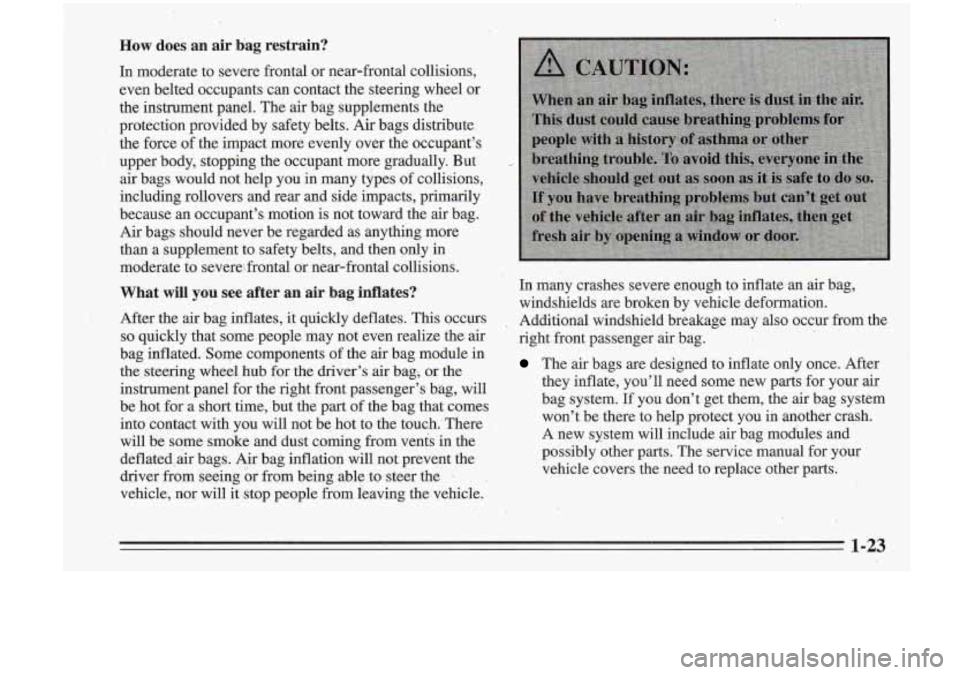
How does an air bag restrain? .*-=
In moderate to severe frontal or near-frontal collisions,
even belted occupants can contact the steering wheel or
the instrument panel. The air bag supplements the.
protection provided by safety belts. Air bags distribute.
the force of the impact more evenly over the occupant’s
upper body, stopping the occupant more gradually. But,
air bags would not help you in many types of collisions,
including rollovers and rear and side impacts, primarily
because an occupant’s motion is not toward the
air bag.
Air bags should never be regarded as anything more
than a supplement to safety belts, and then only in
moderate to severe: frontal or near-fmptal collisions.
What will you see after an air bag inflates?.
After .the air bag inflates, it quickly- deflates. This occurs
so quickly that some people may not even realize the air
bag inflated. Some components
of the air bag module in
the steering whekl hub for the driver’s
air bag, or the
instrument panel for the right front passenger’s bag, will
be hot for a short time,. but the part of the bag that comes
into contact with you will not be hot to the touch.’ There
will be some smoke and dust coming fromvents in the
deflated>air bags.
Air bag inflation will not. prevent the
driver from seeing or from being able to steer the
-
vehicle, nor will it stop people from leaving the vehicle.
,. In many crashes severe enough to inflate an air bag,
windshields are broken by vehicle deformation.
right--front passenger
air bag.
I Additional windshield breakage may also occur from the , . ..
The air bags are designed to inflate only once. AfteT
they inflate, you’ll need some new parts for your air
bag system.
If you don’t get them, the air bag syskm
won’t be there to help protect you in another crash.
A new system will include air bag modbles and
possibly other parts. The service manual for your
vehicle c,overs the need to replace other parts.
Page 56 of 340
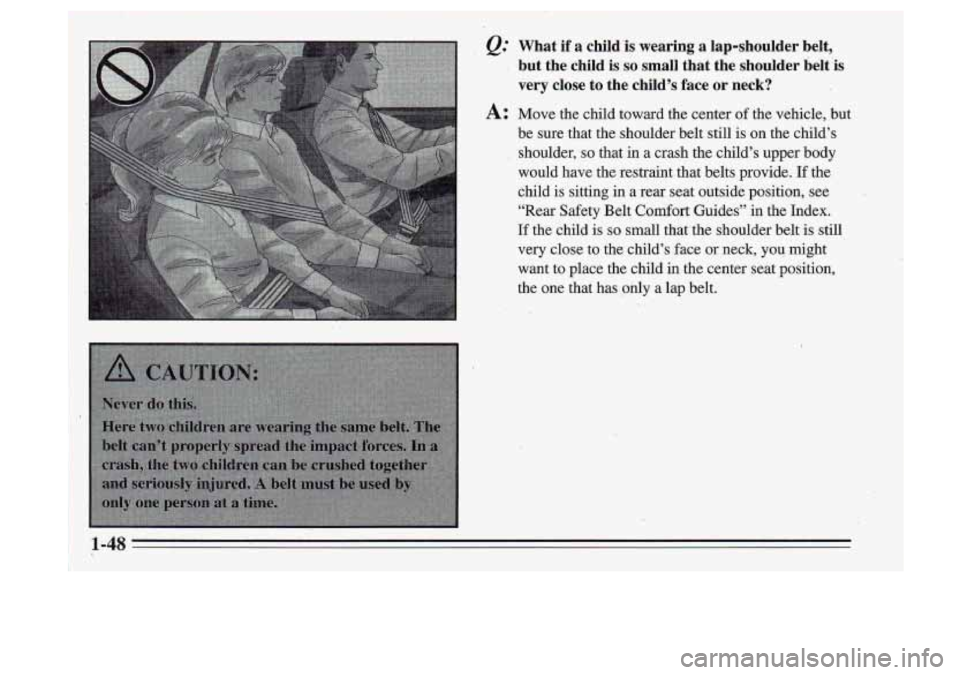
, &.’ What if a childis wearing a lap-shoulder belt,
but the child is
so small that the shoulder belt is
very close to the
child’s face or neck?
A: Move the child toward the center of the vehicle, but
be sure that the shoulder belt still is on
the child’s
:. .? would have the,restraint that belts provide. If the
child is sitting in
a rear seat outside position, see
“Rear Safety Belt,
Comfo~? Guides” in the Index.
If the child is so small thatthe shoulder belt is still
very close to the. child’s face or neck, you might
want to place the child in the center seat position,
the one that has
only a lap belt.
il ,-.
, , . v2 ,”% 5 shoulder, so that in a crash the child’s upper body ,
Page 69 of 340
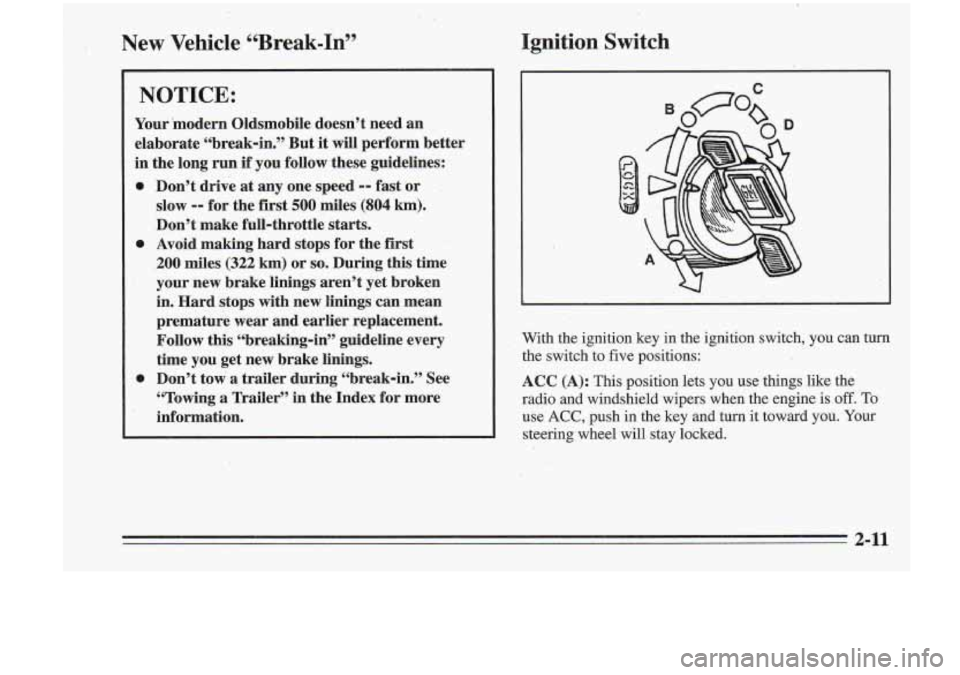
New Vehicle “Break-In” Ignition Switch
NOTICE:
Your *modern Oldsmobile doesn’t need an
elaborate “break-in.” But it
will perform better
in the long run
if you follow these guidelines:
0 Don’t drive at any one speed -- fast or
slow 0- for the first 500 miles (804 km).
Don’t make full-throttle starts.
0 Avoid making hard stops for the fist
200 miles (322 km) or so. During this time
’ your new brake linings aren’t yet broken
in. Hard stops with new linings can mean
premature wear and earlier replacement.
Follow this “breaking-in” guideline every
time you get new brake linings.
0 Don’t tow a trailer during “break-in.” See
“Towing
a Trailer” in the Index for more
information.
..
C
With the ignition key in the ignition switch, you can turn the switch to five positions:
ACC (A): This position lets you use things like the
radio and windshield wipers when the engine is off. To
use
ACC, push in the key and turn it toward you. Your
steering wheel will stay locked.
3-1 I
Page 70 of 340
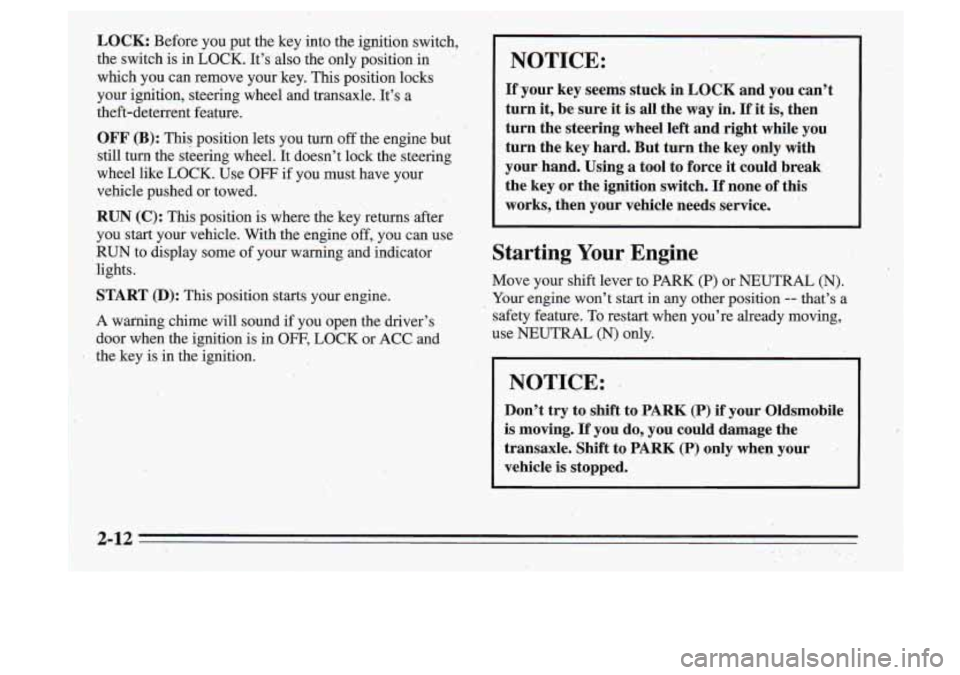
I
I
..
LOCK: Before you put the key into the ignition switch,
the switch' is in LOCK. It's
also the only position in
which you can remove your
key. This position locks
your ignition, steering wheel and transaxle.
It's a
theft-deterrent feature.
OFF (B): This position lets you turn off the engine but "
still turn the steering wheel. It doesn't lock the steering
wheel like LOCK. Use
OFF if you must have your
vehicle pushed or towed.
RUN (C): This position is where the key returns after
you start your vehicle. With the engine
off,. you can use
RUN to display some of your warning and indicator
lights. 1
i ' START (D): T~S position starts your engine.
A wafning chime will sound if you open the driver's
door when the ignition is in OFF, LOCK or ACC and
the key is
in the ignition.
"I
Page 71 of 340
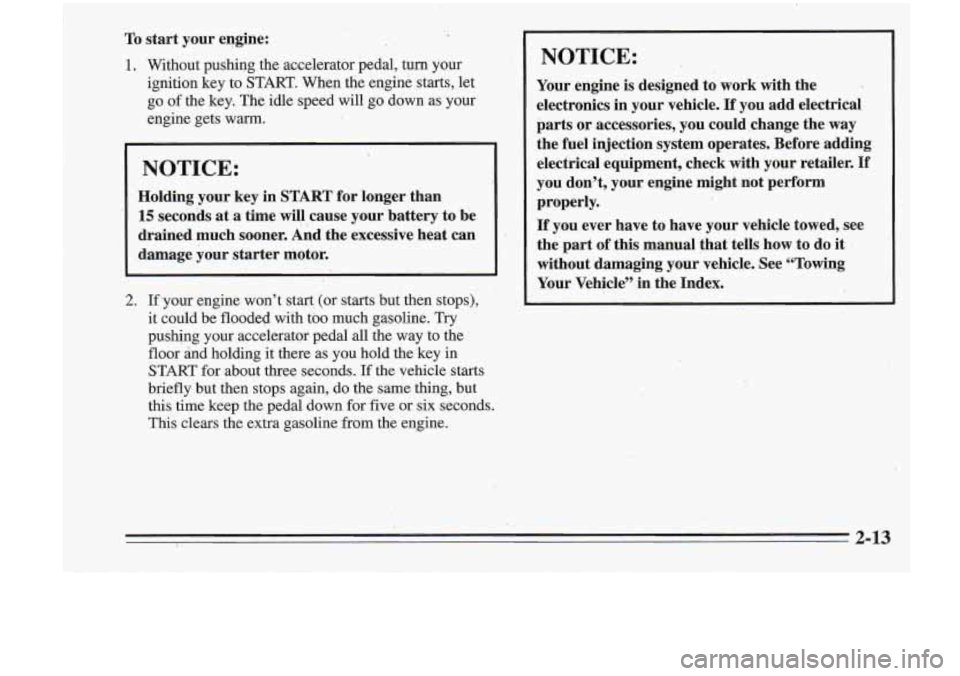
To start your engine:
1. Without pushing the accelerator pedal, turn your
ignition key to
START. When the engine starts, let
go of the key The idle speed will go down as your
engine gets warm.
NOTICE:
Holding your key in START for longer than -- 15 seconds at a time will cause your battery to be
drained much sooner. And the excessive heat can
.damage your starter motor.
2. If-your engine won’t staq (or starts but then stops),
it could be flooded with
too much gasoline. Try
pushing your accelerator pedal all the way to the
floor and holding it there as you hold the key in
START
for about three sec,onds. If the vehicle starts
briefly but then stops again, do the same thing, but
this time keep the pedal down
for five or six seconds.
This clears the extra gasoline from the engine.
I
NOTICE:
Your engine is designed to work with the .
electronics in your vehicle. If you add electrical
parts or accessories, you could,change the
way
the fuel injection system operates. Before adding
electrical equipment, check with your retailer.
If
you don’t, your engine might not perform
properly.
If you ever have to have your vehicle towed, see
the part of this manual that tells how to do
it
without damaging your vehicle. See “Towing
Your Vehicle” in the Index.
\. 2-13
.
Page 74 of 340
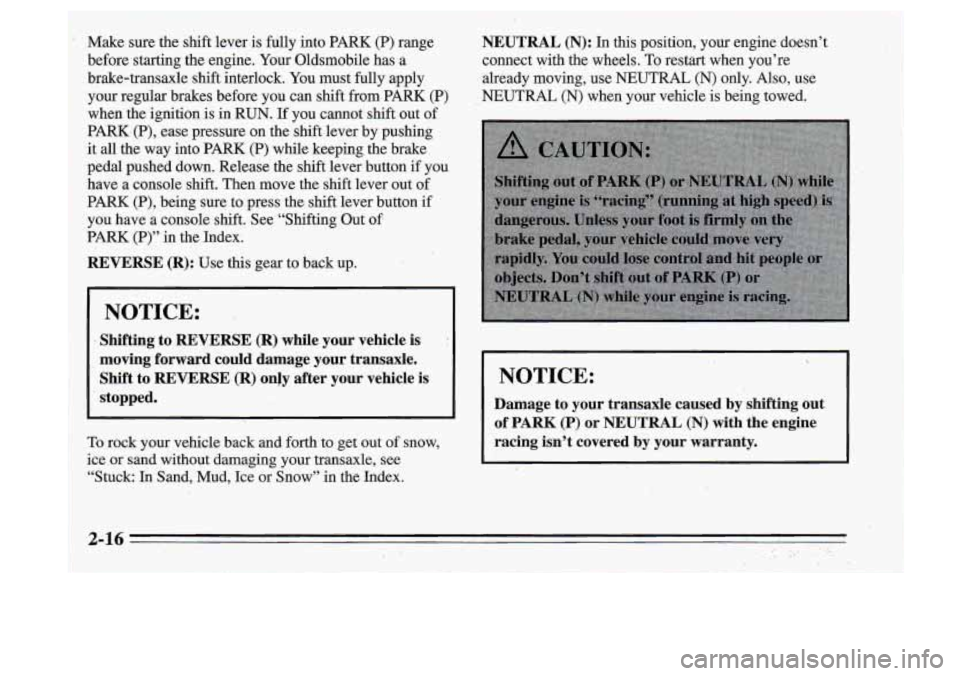
~
~ ~~ ~~~ ~. - ~__~
I!” sure the shift lever
is fully into PARK (P) range
before starting the engine. Your Oldsmobile has a
!brake-transaxle shift interlock. You must fully apply
your regular brakes before you can shift from PARK (P)
Bwhen the ignition is in
RUN. If you cannot shift out of
PARK.(P), ease pressure on the shift lever by pushing
it all the way into PARK (P) while keeping the brake
pedal pushed down. Release the shift lever button
if you
have a console shift. Then move the shift lever out
of
PARK (P), being sure to press the shift lever button if
you have a console shift. See “Shifting Out of
PARK (P)” in the Index.
REVERSE (R): Use this gear to back up.
NOTICE:
Shifting’ to REVERSE (R) while your vehicle is :
moving forward could damage your transaxle.
Shift to REVERSE (R) only after your vehicle
is
stopped.
To rock your vehicle back and forth to get out of snow,
ice or sand without damaging your transaxle, see
“Stuck: In Sand, Mud, Ice or Snow” in the Index.
~ ~~~~
~~~ .
NEUTRAL (N): In this position, your engine doesn’t
connect with the wheels.
To restart when you’re
already moving, use NEUTRAL
(N) only. Also, use
NEUTRAL
(N) when your vehicle is being towed.
I NOTICE:
Damage to your transaxle caused by shifting out
of
PARK (P) or NEUTRAL (N) with the engine
racing isn’t covered by your warranty.
Page 75 of 340
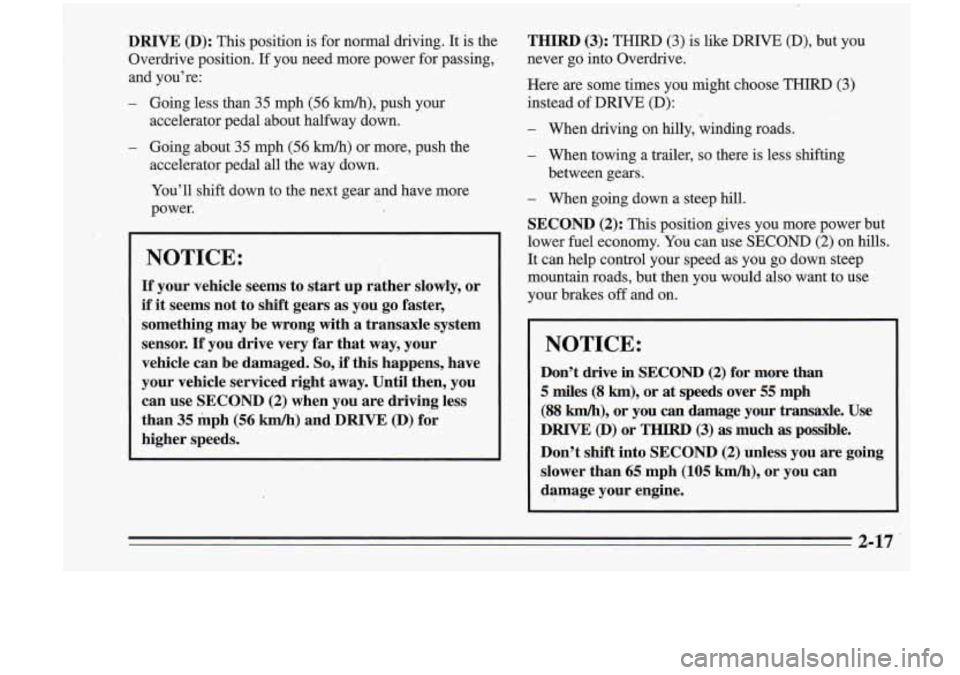
DRIVE (D): This position is for normal driving. It is the
Overdrive position. If you need more power for passing,
and you’re:
- Going less than 35 mph (56 M), push your
accelerator pedal about halfway down.
- Going about 35 mph (56 kmh) or more, push the
accelerator pedal all the way down.
You’ll shift down to the next gear and have more
power.
NOTICE:
If your vehicle seems tb start up rather slowly, or
if it seems not to
shift gears as you go faster,
something
may be wrong with a transaxle system
sensor.
If you drive very far that way, your
vehicle can be damaged.
So, if this happens, have
your vehicle serviced right away. Until then, you
can use SECOND
(2) when you are driving less
than
35 mph (56 km/h) and DRIVE (D) for
higher speeds. THIRD
(3): THIRD (3) is like DRIVE (D),
but you
never
go into Overdrive.
Here are some times you might choose THIRD
(3)
instead of DRIVE (D):
- When driving on hilly, winding roads.
- When towing a trailer, so there is less shifting
- When going down a steep hill.
SECOND
(2): This position gives you more power but
lower fuel economy. You can use SECOND
(2) on hills.
It can help control your speed
as you go down steep
mountain roads, but then you would also want to use
between gears.
lr
brakes off and on.
NOTICE:
Don’t drive in SECOND (2) for more than
5 miles (8 km), or at speeds over 55 mph
(88 km/h), or you can damage your transaxle. Use
DRIVE
@) or THIRD (3) as much aspossible.
Don’t
shift into SECOND (2) unless you are going
slower than
65 mph (105 km/h), or you can
damage your engine.
Page 77 of 340
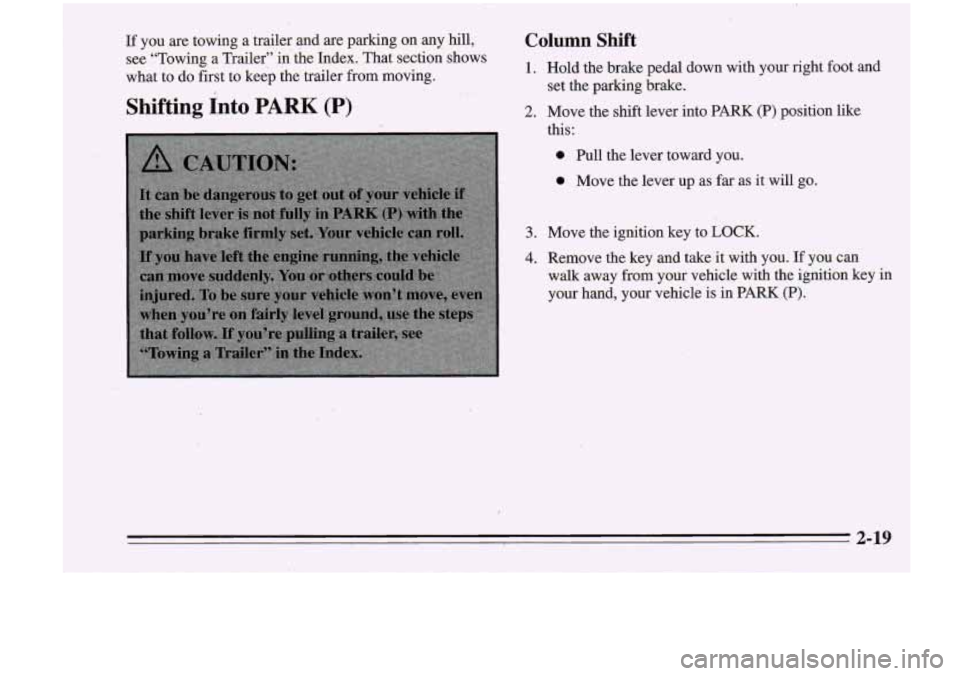
If you are towing a trailer and are parking on any hill, Column Shift
see “Towing a Trailer” in’ the Index. That section shows
what to do first to keep the trailer from moving. 1. Hold’the brake pedal down with your right foot and
set the parking brake.
Shifting Into PARK (P) 2. Move the shift lever into PARK (P) position like
2-19
c
Page 84 of 340
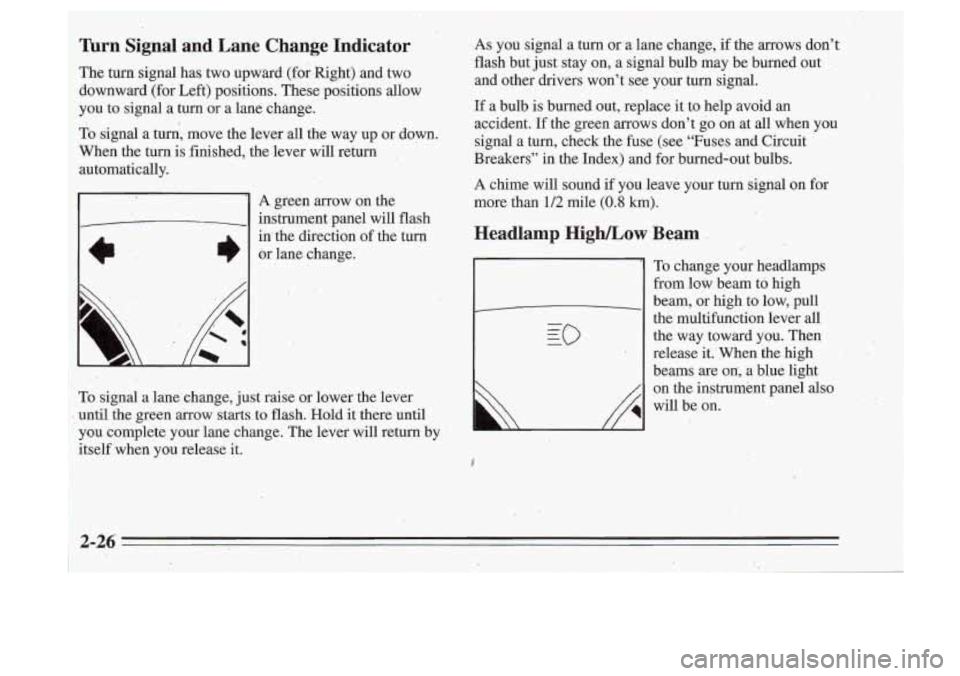
.,’
I
nrn Signal and Lane Change Indicator
The turn signal has two upward (for,Right) and two
downward (for Left) positions. These positions allow
you to signal a turn or a lane, ch&ge.
To signal a turn, move the lever all the way up or down.
When the turn
is finished, the lever will return
automatically.
’ A green arrow on the
- instrument panel will flash
in’the direction
of the turn
e br lane change.
,* I I. ..
To signal a lane change, just raise or lower the lever
until the green
arrow starts. to flash. Hold it there until
you complete your lane change. The lever will return
by
itself when you release it.
..
As you signal a turn or a lane change, if the arrows don’t
flash but Just stay on, a signal bulbmay be burned out
and other drivers won’t see your turn signal.
If a bulb is burned out, replace it to help avoid an
accident. If the green arrows don’t go on at all when you
signal
a turn, check the fuse (see “Fuses and Circuit
Breakers” in the Index) and for burned-out bulbs.
A chime will sound if you leave your turn signal on for
more than,
1/2 mile (0.8 km):
Headlamp HighLow Beam
I
I
To change your headlamps
from low beam to high
beam, or high
to low, pull
the multifunction lever all
the way toward you. Then
release it.’When the high
beams are
oni, a blue light
on the instrument panel also
will be on.
2-26
..
’. . .-. -..